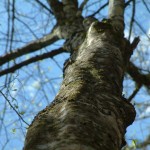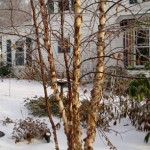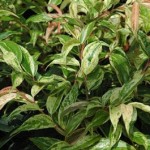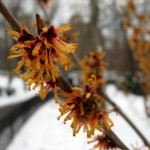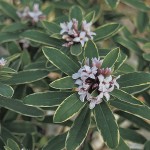The Winter Garden
The snow has finally come to my property. Overnight I have a new garden to enjoy. The spring garden with bulbs and blooming shrubs is one garden; the summer garden with perennial flower beds and annuals and tropicals scattered about in containers is another. In fall there are fewer flowers, but the trees and shrubs put on a dramatic, colorful display.
In winter, all the hidden beauties of my garden get to take center stage. Also in winter, I have the one time of year when I can contemplate additions to my garden without distractions. More about that in a moment.
Stop and look to see what the winter garden offers. Paperbark and river birch trees grab attention with beautiful peeling bark. Much of the year, that bark is hidden by leaves. Only with the leaves gone can these beautiful trees be clearly appreciated. But birches are hardly alone. Many Kousa dogwoods offer a patchy bark that provides a melody of colors on each branch. Trident and paperbark maples provide layers of color as bark peels, unexpected after a summer of great shade. Hornbean trees look like body builders showing off with their rippling muscular bark. Stewartia offer a patchwork of color worthy of Grandmother’s crazy quilt.
In front of my home, a young oxydendron (sourwood tree) has no special bark, but it displays its classic shape and many branches decorated with the dried panicles from its mid-summer flowers.
Shrubs come out of the shadow of flowers in winter. A golden chamaecyparis and a blue juniper that sit quietly in a flower bed all summer jump out to take center stage now that the competition is asleep. Leucothoe ‘Rainbow’ is a shade loving evergreen that, instead of needles or waxy leaves, greets you with waves of soft leaves that are green — and yellow and white and touched with pink. The shrub is beautiful all year but only gets the attention it deserves in winter. Amazingly, the Itea, a pretty native shrub with white flowers in the spring and green foliage that make everything around it look better all summer, is still holding onto those leaves, now red and peach and orange and carmine.
Witchhazel, a shrub your grandmother grew, is getting ready to bloom. The new varieties have more flowers, but the older varieties have a scent that will enchant you if you clip off a branch and bring it into the house. Most witchhazels bloom while the snow is still on the ground—assurance that spring will come. My Daphne ‘Transatlantica’ sits half-covered with snow, but on the uncovered parts, small white flowers offer up their intoxicating scent. Winterberries are show stoppers until the birds have removed the last of the bright red berries Less showy, but equally attractive to the birds are viburnum.
And speaking of birds, the bluebird or cardinal, the woodpecker and even the blue jay become show stoppers in the winter garden. You can put out feeders to attract them, but if you grow the berries they love, provide shelter and give them some fresh clean water, you will have them in your garden year round.
Your winter garden may be hidden from your window view if the shrubs were placed directly against the house. For many decades (no, it wasn’t always so) many developers and homeowners planted shrubs one-deep along the foundation. Honestly, no law says you must landscape your house this way. Placing shrubs and trees out in the yard means you get to enjoy your garden – your winter garden – when the weather keeps you indoors.
My two favorite winter views are of the shrubs and trees planted around our front yard and the ‘back yard’ garden going down a slope which was designed to look best from the house, not when you are actually in the garden. Our perennial beds are dotted with dwarf and not-so-dwarf shrubs that provide life and interest to otherwise dormant areas.
While you look out your window at the frozen landscape, you can make some new plans. Find the areas that cry out for you to add something especially for the winter garden. Consider a walk at the Massachusetts Horticultural Society, starting at the entrance garden designed last year by Paul Miskovsky. Continue your stroll to the five year old Bressingham Garden and finally the century old Italianate Garden in front of the mansion– all created to provide year round interest. They offer three very different ways of approaching a landscape. And in those gardens are the plants that will bring your winter landscape to life.
Take along pen and paper and make a list of the plants you’d like to see when you look out the window. In the spring, go shopping for some of those plants that you might otherwise ignore as the nurseries fill up with spring flowering specimens. Then plant them in the middle of the yard, out by the edge of your sidewalk, or anywhere you look out the window. Next winter—and for many winters to come—you’ll be glad you did.
